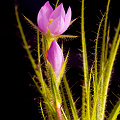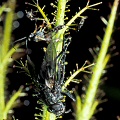Q: Roridula: the vliegebos
A: The genus Roridula consists of but two species, off by
themselves in a lonely plant family called the Roridulaceae. Looking at the plant, you might think to yourself, "Ahhh,
another one of those sticky flypaper-type carnivores." But the situation is far more complicated and interesting than
that. Indeed, there are those who scoff my including this in the Carnivorous Plant FAQ at all! Read on...
The two species of Roridula are found in South Africa, where they live in nutrient poor, moist
locations. They grow alongside many carnivorous plants such as Drosera, and like
plants in that genus, capture bugs on their sticky leaves. There is no leaf or glandular motion, the plant merely
captures bugs passively. When European botanists first observed Roridula, the plants
were thought to be straightforward
carnivores. Ahh, but something is a little different about Roridula: unlike the herbaceous sundews,
Roridula is a woody shrublet. And the plot thickens even more...
In the early 1900s, the botanist Marloth pointed out that, unlike other sticky flypaper plants that produce leaves
covered by mucus glands, the leaves of Roridula are covered with resin glands. This is a key difference.
Mucus is water-based, resin is not. (Did you ever try to wash pine sap off your hands just using water?) Digestive enzymes and
nutrients can easily diffuse through mucus, but they cannot diffuse through resin. Therefore, bugs captured by
Roridula cannot be enzymatically digested or absorbed. In a cruel summary of this
situation, F.E. Lloyd discussed the noncarnivorous nature of Roridula in the same paragraphs in
which he discounted the mythic "Man-eating plant of Madagascar." Times were sad for poor
Roridula. Subsequent tests that demonstrated that the plants did not produce
digestive enzymes seemed to permanently close the files on carnivory in Roridula.
But still, still there were those who clung to hopes that Roridula might be carnivorous. And
their hope was, in time, rewarded...
The complicating factor with Roridula is that, although the leaves are glandular-resinous and sticky
in the extreme, there are hemipteran insects (Pameridea spp., informally
called assassin bugs)
which crawl around on them, and even make the plants home. These
insects are very specialized carnivores. It seems that these creatures do not become stuck to the plant because they are covered
with a thick, greasy layer that Roridula cannot adhere to.
The Pameridea stand guard on the leaves, and when an insect becomes trapped by the
plant the Pameridea swarm onto the prey. They stab the captured insect with their long lance-like
mouthparts, and suck out the insect's insides. Quite horrible. Then, the Pameridea
ultimately poop. And this is where things really get interesting...
Apparently, the Pameridea poop is absorbed by the Roridula leaf
surfaces. Experiments using nitrogen isotopes prove that in the presence of Pameridea,
the plants absorb nutrients from the captured bugs more efficiently. Indeed, test indicate that
Roridula may obtain around 70% of all its nitrogen from captured prey--a rate that is comparable with
Drosera.
It is commonly said that Pameridea marlothii lives on
R. dentata and Pameridea roridulae occurs only on
R. gorgonias. However, Stew McPherson tells me that the situation is more complicated, and that
Pameridea marlothii can occur on both species of
Roridula but mostly on
R. dentata, while Pameridea roridulae frequently occurs on both species
of Roridula. McPherson also believes that the taxonomy of this group is out of date, and that there
are many more species of Pameridea awaiting description.
Complicating things even more, there is a species of specialist spider (Synaema marlothi) that also lives on
Roridula and preys upon captured insects as well as upon Pameridea.
Its poop may very well end up being absorbed by Roridula too!
It was discovered in 2007 that Pameridea are not restricted to feeding on
animal prey---they are generalist feeders that
suck the juices of Roridula if food is not present. This helps sustain the
Pameridea if captured food becomes rare. But this is also a factor in an
interesting balance that apparently exists regarding the populations of Pameridea on
Roridula plants. If the populations of Pameridea are very low, the plant
suffers because it is not getting the nitrogen it needs. But if the populations of Pameridea become
too large, the Pameridea begin to feed upon the saps of the Roridula,
thereby damaging it. Perhaps the Synaema marlothi spiders help keep the
Pameridea populations in check?
Roridula does not produce its own digestive enzymes. But
using my definition of carnivory, the
mutulism of Roridula and Pameridea is entirely sufficient for this
plant to be considered carnivorous. Furthermore,
the leaf cuticle (the protective waxy coating) of Roridula is very thin and has many
gaps in it. Similar cuticular gaps are on the leaves of Pinguicula and are the pathway by which
nutrients are absorbed into the leaves of that carnivorous genus. Cuticular gaps are somewhat risky, since it opens the plant
up to possible excessive water loss and also invasion by pests and pathogens, but apparently the risk is worth the
benefits for Roridula.
Another way to look at the argument is via analogy to the pitcher plant
Darlingtonia. Both Roridula and Darlingtonia
capture large numbers of insects. Neither plant produces
digestive enzymes, but both have relationships with insects that live with the plant and digest the captured prey. If I were to
exclude Roridula from the ranks of carnivorous plants purely based upon the lack of enzyme production,
I would have to remove
Darlingtonia too, and I consider that excessive. Call it carnivorous or not; ultimately the
problem is that we are trying to fit plants into simple, black and white categories,
and nature is not so easily catalogued. Do what you will, but know there is no simple answer.
Incidentally, some authors claim that Roridula can occasionally
capture birds. If indeed so, this would be the only example of a plant capturing birdlife. But it is not clear to me if the
nutrients from the birds are being absorbed by the plant. Furthermore, even if this sticky shrub manages to capture an
occasional bird, it far more commonly captures invertebrates and as such I would not really call it a bird-eating
plant! Crazy, though, ain't it?
As a common name, Roridula is usually just referred to by its genus name. However, Obermeyer cites
the Afrikaan name vlieëbos" (or vliegebos), and Smith says it is called the "flycatcher bush." These names, though, are so
rarely used that they are news even to dedicated carnivorous plant nuts.
Page citations: Anderson, B. 2005; Anderson, B. and Midgley, J.J. 2002, 2003,
2007;
Ellis, A.G. & Midgley, J.J. 1966; Juniper, B.E., et al. 1989; McPherson, S. 2008;
Obermeyer, A.A. 1970; Lloyd, F.E. 1942; Rice, B.A. 2006a; Smith, C.A. 1966; Voigt, D., & Gorb, S. 2008.


